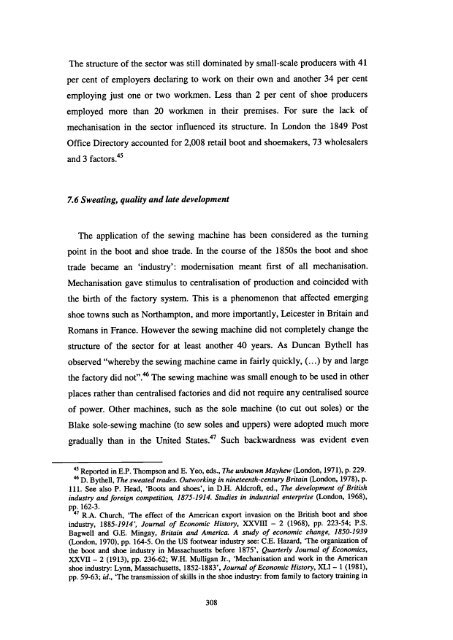The Boot and Shoe Trades in London and Paris in the Long Eighteenth Century
The Boot and Shoe Trades in London and Paris in the Long Eighteenth Century
The Boot and Shoe Trades in London and Paris in the Long Eighteenth Century
You also want an ePaper? Increase the reach of your titles
YUMPU automatically turns print PDFs into web optimized ePapers that Google loves.
<strong>The</strong> structure of <strong>the</strong> sector was still dom<strong>in</strong>ated by small-scale producers with 41<br />
per cent of employers declar<strong>in</strong>g to work on <strong>the</strong>ir own <strong>and</strong> ano<strong>the</strong>r 34 per cent<br />
employ<strong>in</strong>g just one or two workmen. Less than 2 per cent of shoe producers<br />
employed more than 20 workmen <strong>in</strong> <strong>the</strong>ir premises. For sure <strong>the</strong> lack of<br />
mechanisation <strong>in</strong> <strong>the</strong> sector <strong>in</strong>fluenced its structure. In <strong>London</strong> <strong>the</strong> 1849 Post<br />
Office Directory accounted for 2,008 retail boot <strong>and</strong> shoemakers, 73 wholesalers<br />
<strong>and</strong> 3 factors.45<br />
7.6 Sweat<strong>in</strong>g, quality <strong>and</strong> late development<br />
<strong>The</strong> application of <strong>the</strong> sew<strong>in</strong>g mach<strong>in</strong>e has been considered as <strong>the</strong> turn<strong>in</strong>g<br />
po<strong>in</strong>t <strong>in</strong> <strong>the</strong> boot <strong>and</strong> shoe trade. In <strong>the</strong> course of <strong>the</strong> 1 850s <strong>the</strong> boot <strong>and</strong> shoe<br />
trade became an '<strong>in</strong>dustry': modernisation meant first of all mechanisation.<br />
Mechanisation gave stimulus to centralisation of production <strong>and</strong> co<strong>in</strong>cided with<br />
<strong>the</strong> birth of <strong>the</strong> factory system. This is a phenomenon that affected emerg<strong>in</strong>g<br />
shoe towns such as Northampton, <strong>and</strong> more importantly, Leicester <strong>in</strong> Brita<strong>in</strong> <strong>and</strong><br />
Romans <strong>in</strong> France. However <strong>the</strong> sew<strong>in</strong>g mach<strong>in</strong>e did not completely change <strong>the</strong><br />
structure of <strong>the</strong> sector for at least ano<strong>the</strong>r 40 years. As Duncan By<strong>the</strong>ll has<br />
observed "whereby <strong>the</strong> sew<strong>in</strong>g mach<strong>in</strong>e came <strong>in</strong> fairly quickly, (...) by <strong>and</strong> large<br />
<strong>the</strong> factory did not". <strong>The</strong> sew<strong>in</strong>g mach<strong>in</strong>e was small enough to be used <strong>in</strong> o<strong>the</strong>r<br />
places ra<strong>the</strong>r than centralised factories <strong>and</strong> did not require any centralised source<br />
of power. O<strong>the</strong>r mach<strong>in</strong>es, such as <strong>the</strong> sole mach<strong>in</strong>e (to cut out soles) or <strong>the</strong><br />
Blake sole-sew<strong>in</strong>g mach<strong>in</strong>e (to sew soles <strong>and</strong> uppers) were adopted much more<br />
gradually than <strong>in</strong> <strong>the</strong> United States. 47 Such backwardness was evident even<br />
45 Reported <strong>in</strong> E.P. Thompson <strong>and</strong> E. Yeo, eds., <strong>The</strong> unknown Mayhew (<strong>London</strong>, 1971), p. 229.<br />
46 D. By<strong>the</strong>ll, <strong>The</strong> sweated trades. Outwork<strong>in</strong>g <strong>in</strong> n<strong>in</strong>eteenth-century Brita<strong>in</strong> (<strong>London</strong>, 1978), p.<br />
111. See also P. Head, '<strong>Boot</strong>s <strong>and</strong> shoes', <strong>in</strong> D.H. Aldcroft, ed., <strong>The</strong> development of British<br />
<strong>in</strong>dustry <strong>and</strong> foreign competition, 1875-1914. Studies <strong>in</strong> <strong>in</strong>dustrial enterprise (<strong>London</strong>, 1968),<br />
pp. 162-3.<br />
'' R.A. Church, '<strong>The</strong> effect of <strong>the</strong> American export <strong>in</strong>vasion on <strong>the</strong> British boot <strong>and</strong> shoe<br />
<strong>in</strong>dustry, 1885-1914', Journal of Economic History, XXVffl - 2 (1968), pp. 223-54; P.S.<br />
Bagwell <strong>and</strong> G.E. M<strong>in</strong>gay, Brita<strong>in</strong> <strong>and</strong> America. A study of economic change, 1850-1939<br />
(<strong>London</strong>, 1970), pp. 164-5. On <strong>the</strong> US footwear <strong>in</strong>dustry see: C.E. Hazard, '<strong>The</strong> organization of<br />
<strong>the</strong> boot <strong>and</strong> shoe <strong>in</strong>dustry <strong>in</strong> Massachusetts before 1875', Quarterly Journal of Economics,<br />
XXVII - 2 (1913), pp. 236-62; W.H. Mulligan Jr., 'Mechanisation <strong>and</strong> work <strong>in</strong> <strong>the</strong> American<br />
shoe <strong>in</strong>dustry: Lynn, Massachusetts, 1852-1883', Journal of Economic History, XLI - 1(1981),<br />
pp. 59-63; id., '<strong>The</strong> transmission of skills <strong>in</strong> <strong>the</strong> shoe <strong>in</strong>dustry: from family to factory tra<strong>in</strong><strong>in</strong>g <strong>in</strong><br />
308


